How to Fix Low Water Pressure in a Bathroom Sink
Author: Omar Alonso | Editor: Omar Alonso
Review & Research: Jen Worst & Chris Miller
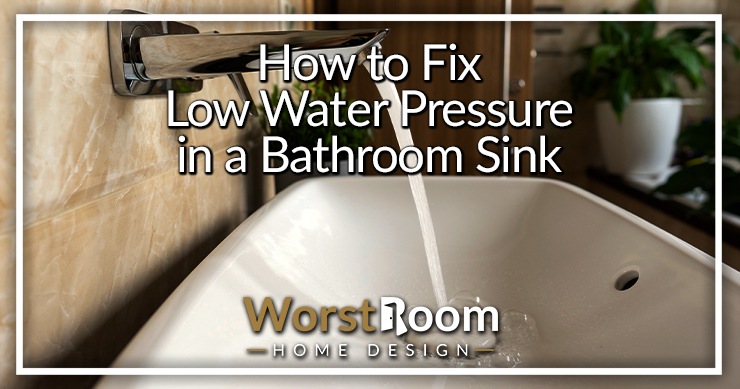
Is the water dribbling out of your faucet when it should be a raging torrent? Chances are the pressure in the pipes is low. What causes low water pressure in a bathroom sink?
It's a common problem, and there's usually a simple fix, but in some cases, it might take some time and effort to locate the source of the issue. Let's look at how to increase water pressure in a bathroom sink.
Is Low Water Pressure a Temporary Problem?
Sometimes, you might be experiencing low water pressure in the sink due to a problem with the local water supply. There might be a leak in the line somewhere, and the council is working on it. Don't assume the worst that it's a problem in your plumbing. Contact the local utility company or review their website or social media feeds to see if your area has a problem.
Sometimes, the issue with low water pressure in the bathroom sink might be because someone else is using the water in another location of the house. For instance, if your partner is watering the garden, it might cause a slight drop in the water pressure in the sinks.
What Causes Low Water Pressure in Bathroom Sinks?
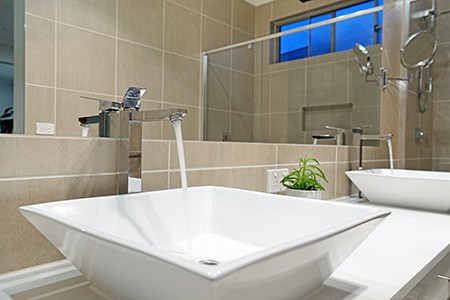
If you're confident there's no local outage or it's not a problem resulting from too many open faucets in the house, it could be due to one of the following issues. Look through all of these in order to figure out how to fix water pressure in your bathroom sink. It could be one or multiple (less likely) of these issues.
Test the Hot & Cold Water Faucets
Let's start by assessing whether the problem is to do with both the hot and cold water systems in your plumbing. You might have a problem with one faucet but not the other. Test both to see if you have a consistent problem or if it's just affecting one of the water delivery lines. Make sure you know if a valve is open or closed.
Turn on each of the faucets one at a time. Open it to the full position and compare the water flow between them. If the hot water pressure is low and the cold water pressure is fine, you have a problem with the hot water delivery system, and vice versa.
If the hot water pressure is low, it's usually a problem with the water heater. Inspect the area around the water heater's floor and look for leaks coming from the bottom of the unit. That's a good point though. Determine if the low water pressure in the bathroom sink is coming from the hot or cold side.
Check the Shut-off Valves
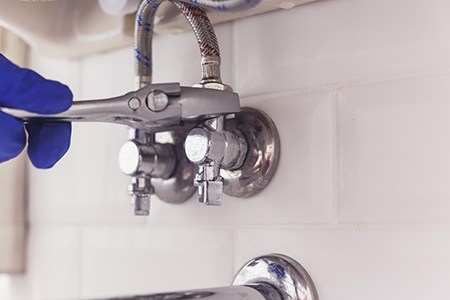
Did you recently replace your faucets? That might be the cause of the issue. Check that the shut-off valves are in the fully open position. If the valves are partially closed, it disrupts the optimal water flow through the faucets, resulting in a problem that looks like low water pressure.
You'll find the shut-off valves below the sink. Usually, they have a plastic oval top with a raised seem, allowing you to turn them by hand or with a wrench. They're in the fully open position if the line on the plastic part is parallel to the water line and valve.
Check the Water Aerator
If the shut-off valve is open, check the water aerator. The aerator is a mesh part made from metal or plastic. It aerates the water, improving the pressure and flow rate through the faucet.
The aerator also acts as a filter, trapping debris and dirt, preventing it from entering the water and moving out of the faucet. If there's a blockage in the aerator, it reduces the water flow through the taps.
Check the Flow Restrictor
The flow restrictor is a plastic disc inserted into the water line before the faucet aerator. The flow restrictor has several holes in it to regulate water flow through the faucet. You can remove these even in a shower head.
Remove the restrictor and inspect it for blockages. Clean the restrictor if you notice any blockages. It's common for mineral deposits to accumulate on the restrictor, further limiting water flow through it.
Check the Water Supply Lines
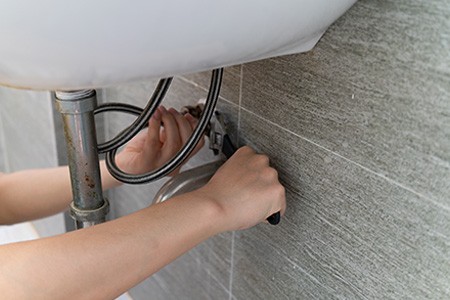
If none of the above checks resulted in your finding any problems, the issue might be with the supply lines. It's common for new homes to experience a blockage of debris in the pipes. It's a bit more challenging to clean and flush the lines, but we have a step-by-step process for your to follow.
1) Close the Shut-Off Valves
Start by closing the shut-off valves under the sink. Ensure the line on the valve is perpendicular to the valve body. You can also turn off the water main, which turns off the water to the house. Some apartments may not have access to a water main.
2) Turn the Water Off & Drain the Water Lines
Turn on the hot and cold faucets to drain water in the lines. After they finish draining, turn the tap off again.
3) Remove the Water Line
Disengage the water supply lines from the faucets. You'll need a wrench for the task, and they might be in a hard-to-reach area.
4) Flush the Water Lines
Find a bucket and place the water supply lines in it. Turn the water supply valves back to the open position by turning them anti-clockwise until the valve line is parallel to the valve body. Water comes out of the supply lines and into the bucket. Let it run for around 45 seconds, and anything blocking the lines comes into the bucket.
5) Attach the Water Lines
After removing the blockage, reattach the water supply lines to the faucets. Ensure you tighten them with the wrench properly. Under tightening them will cause them to leak. However, don't overtighten them, or you risk stripping the threads, making it hard to remove them again.
If you closed the water main, this is the time to reopen it. After checking everything is connected properly:
- Turn the shut-off valves back to the open position.
- Run the faucets and see if it affects the water pressure.
- Check underneath the sink to ensure there are no leaks.
The low water pressure in your bathroom sink should be solved now, assuming this was the problem.
Check the Water Heater
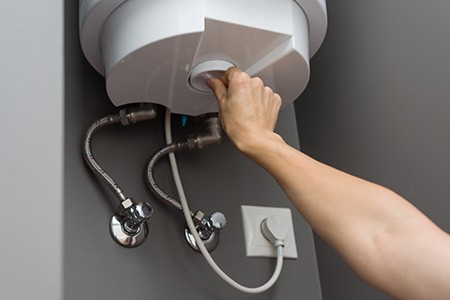
If you don't have any luck with clearing the faucets of the supply lines, it might be the water heater causing the issue. Check the pilot light is on and look around the tank to ensure no water exits it. The water heater can leak from the top or bottom. If you notice a leak, you'll need to turn off the heater and examine it to locate the source of the problem.
All water heaters have a service life. Most models last ten to 15 years. If you have an older model, it's reached the end of its service life and needs replacing. Or it could require minor repairs. In most cases, unless you have experience with water heaters, you'll need a plumber to look at it for you.
If you don't address the leak, it will get worse. Eventually, the unit will fail and spray water all over the attic or basement. If the water heater leaks, it causes low water pressure in the hot water system in all faucets in the house.
Check for Leaks in Your Plumbing
Another common reason for low water pressure in the cold water system is a leak in one of the pipes. Like your water heater, plumbing has a service life and will eventually perish. If you live in an old house, chances are there's a problem with the plumbing. These can be obvious, but overlooked reasons your bathroom faucet water pressure is low.
Inspect the plumbing in the bathroom, laundry, and kitchen. If you can see any obvious leaks, call a plumber for assistance. Some plumbing problems are easy to replace with DIY strategies, while others require the aid of a professional.
FAQs Regarding Bathroom Sink Water Pressure
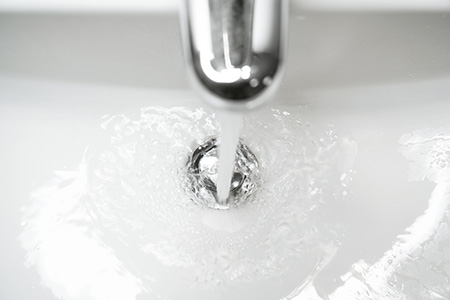
When the question of low water pressure in a bathroom sink arises, so many other questions come up. Let’s deal with those now.
What's the Most Common Cause of Low Water Pressure in Sinks?
Clogs in your plumbing are usually the most common causes of low water pressure in the cold water system. Clogged drain pipes have nothing to do with low water pressure, but clogs in the delivery system will lower water pressure throughout the home.
Why is the Water Pressure in a Sink Low But Fine Everywhere Else in the House?
If the water pressure in the bathroom sink is low but fine everywhere else in the house, the issue might be with the fixture itself. The most common causes of low water pressure in bathroom sinks are clogged cartridges, flow restrictors, or aerators.
How Do I Increase Water Pressure in Sinks?
One of the easiest methods for improving water pressure in bathroom sinks is to adjust the faucet's pressure-reducing valve. You can usually find the valve close to the water main or the water meter. You can make slight adjustments to improve water flow through the system if the pressure gauge has a low reading.
Key Takeaways for Low Water Pressure in a Bathroom Sink
- If you have low water pressure in the bathroom sink, check if it affects the cold and hot water systems.
- Check to see if the low pressure affects all faucets in the house.
- If only the bathroom faucet is problematic, it's usually a problem with the fixture or the supply lines/valve.
- The most common issues with fixtures causing low water pressure are clogged aerators or flow restrictors.
- If the hot water pressure is low, the water heater is likely causing the problem.
- Check the water heater for signs of leaks.
- If you can't find the cause of the low water pressure, check with the council for outages in your area.
- Call a plumber to assist with the problem if there's no local outage.
That’s How to Fix Bathroom Sink Water Pressure Low Issues
Above we’ve provided several mechanisms to check that may be impeding your water flow and the steps to proceed through to fix it. Low water pressure in a bathroom sink doesn’t have to be an endless frustration. Follow our advice above and you’ll be able to put it out of your mind, nice and satisfied.



